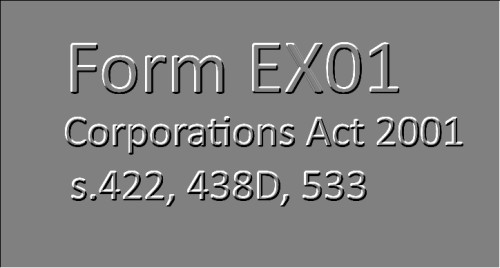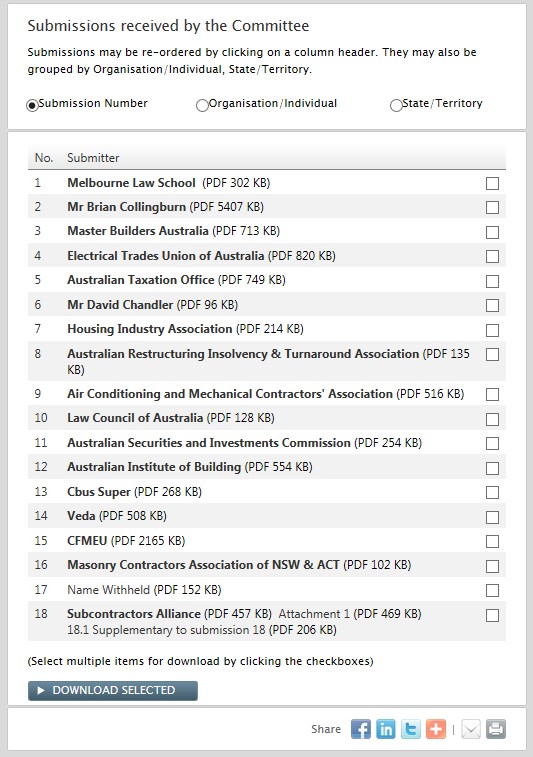UPDATED 16/1/2015
Despite directors receiving official admonishments, detailed instructions and threats about the practice of allowing a company to trade whilst insolvent (see, for example, ASIC Regulatory Guide 217), the curse of insolvent trading seems to be growing.
So, in an attempt to reel it in – or perhaps (for the cynical) to reduce the number of reported cases – the Australian Securities and Investments Commission (ASIC) is putting the onus on liquidators to provide “better” information in their statutory reports.
Background
Where liquidators of insolvent companies become aware that a past or present director or other officer of a company may have committed an offence, they are required to make a formal report to ASIC. Several years ago ASIC came up with a form and guidelines spelling out the information it wanted from liquidators before it would take their allegations of offences any further. This change came with the introduction of an electronic means of lodging reports, but also occurred after ASIC had become fed-up with receiving offence reports considered by its investigators to be almost worthless.
The latest version of this offence report form was released on 18 December 2014. The changes that have been drawn to the attention of liquidators by ASIC concern allegations of insolvent trading. The previous version of the form (July 2008) asked little of liquidators regarding this subject: about all it wanted was a “Yes” or “No” on the availability of documentary evidence. But the new version requires far more.
In the insolvency profession the ASIC form is known as EX01. More technically it is Schedule B of Regulatory Guide 16: Report to ASIC under s422, s438D or s533 of the Corporations Act 2001 or for statistical purposes. (Note: This reporting requirement applies not only to liquidators but also to receivers or managing controllers and voluntary administrators. However for simplicity all these classes of external administrators are referred to collectively in this article as liquidators.)

Possible Misconduct – EX01
In EX01 reporting of “insolvent trading” is carried out in the section headed Possible Misconduct.
Here, ASIC asks the liquidator “Are you reporting possible misconduct?”
If the answer is “Yes”, the liquidator is invited to examine Schedule D of ASIC Regulatory Guide 16 to learn “what is likely to constitute a breach of the relevant section, and the evidence needed to prove such a breach”. Schedule D contains over 6,500 words.
There is also a warning “that ASIC may ask you to provide a supplementary report addressing in detail the possible misconduct reported and we may later require further evidence or statements from you for Court purposes”. A description of what is required in the ASIC supplementary report is set out in Schedule C: Supplementary report by receiver or managing controller under s422(2), by voluntary administrator under s438D(2), or by liquidator under s533(2). Schedule C contains about 3,000 words. Liquidators of “assetless companies” are eligible under Regulatory Guide 109 to apply for funding from ASIC for reasonable remuneration and costs in preparing a supplementary report (ASIC form EX03).
If, after considering what is involved in answering “Yes”, the liquidator still thinks the misconduct is worth reporting, or filing a complaint, he or she is directed to the section headed “Criminal Offences”.
Possible Misconduct – Criminal Offences – Insolvent Trading – EX01
Preliminary details of an allegation of insolvent trading – an offence under section 588G(3) of the Corporations Act 2001 – are sought by ASIC in the usual tick-the-box manner.
First the liquidator reports the alleged offence by ticking “Yes” to the following statement:
“In your opinion, one or more directors failed to prevent the company incurring a debt or debts at a time when the director suspected that the company was insolvent or would become insolvent as a result, and the failure to prevent the company incurring the debt(s) was dishonest.”
Having ticked that box, the liquidator is asked “Do you have documentary evidence or other to support your opinion?” and “Are you aware of documentary evidence in the possession of another person that supports this allegation?”
Up to this section the revised form is practically the same as the previous version.
But in the new version, if the liquidator reports a case of insolvent trading and has, or knows of, documentary evidence supporting this conclusion, the liquidator must provide more information by answering several extra questions.
These extra questions concern the period of insolvency, the methods and records used to determine the date of insolvency, the amount of debts incurred, and the reasonable grounds for the director had to suspect insolvency. (The actual questions are set out verbatim below, but the heading are mine.) They are the type of questions that a liquidator, especially one with sufficient funds, ought to consider as a matter of course before reaching an opinion regarding the existence (or non-existence) of insolvent trading.
Effects of changes to insolvent trading sections of EX01
Prior to the recent changes, if ASIC saw a completed EX01 form in which the liquidator had alleged a breach of the insolvent trading laws, and had also answered “yes” to questions about the possession or existence of documentary evidence “or other” to support that opinion, ASIC would have then needed to consider whether to investigate. Its task would likely have entailed obtaining, or trying to obtain, from the liquidator the extra information that is now set out in the latest version of EX01. So, as far as the extra demands in the form are concerned, ASIC would probably argue that liquidators are no greater imposed upon now than they were before.
But regardless of the information ASIC has or could readily obtain, it often decides not to investigate complaints of alleged offences. For many years this inaction has deeply frustrated a lot of liquidators. Many feel that completing an EX01 form is a waste of their time and also, where there are still funds in the insolvent company, a waste of creditors’ money. Unless the revised EX01 results in greater tangible action by ASIC (increased investigations and prosecutions and not just more detailed statistics), making the form more demanding will aggravate these feelings.
It might even see an increase in the non-reporting of insolvent trading offences (see the new question “Reasons for not reporting insolvent trading”), or in “no” being the liquidator’s response when it really should be “yes”.
Extra questions about insolvent trading – new EX01
Period insolvency commenced
Indicate the period, which, in your opinion, the company became unable to pay all its debts as and when they became due and payable:
◻ At appointment ◻ 1 – 3 months prior to appointment ◻ 4 – 9 months prior to appointment ◻ 10 – 15 months prior to appointment ◻ 16 – 24 months prior to appointment ◻ Over 2 years prior to appointment
Method/s of determining date of insolvency
How did you determine the date on which, in your opinion, the company became unable to pay all its debts as and when they became due and payable? (tick one or more):
◻ Cash flow analysis ◻ Trading history analysis ◻ Balance sheet analysis ◻ Informed by director(s) ◻Other, please specify __________________
Records used to determine date of insolvency
Which of the following records, in your possession, did you use to determine the date on which, in your opinion, the company became unable to pay all its debts? (tick one or more):
◻ Cash flow (actual / forecasts / budgets) ◻ Banking records ◻ Aged debtors’ list ◻ Aged creditors’ list ◻ Profit & loss statements ◻ Balance sheets ◻ Other, please specify _______________
Grounds for director to suspect insolvency
If you believe the director had reasonable grounds to suspect the company was insolvent or would become insolvent by incurring the debt (or a reasonable person in a like position would have reason to suspect), please identify on which of the following indicators of insolvency you have based your belief (tick one or more):
◻ Financial statements that disclose a history of serious shortage of working capital, unprofitable trading ◻ Poor or deteriorating cash flow or evidence of dishonoured payments ◻ Difficulties paying debts when they fell due (e.g. evidenced by letters of demand, recovery proceedings, increasing age of accounts payable) ◻ Non-payment of statutory debts (e.g. PAYGW, SGC, GST) ◻ Poor or deteriorating working capital ◻ Increasing difficulties collecting debts ◻ Overdraft and/or other finance facilities at their limit ◻ Evidence of creditors attempting to obtain payment of outstanding debts ◻ Other, please specify ________________
Approximate debt after insolvency
Estimate the approximate amount of debts incurred after the date (in your opinion) of insolvency:
◻ $0 – $250,000 ◻ $250,001 – less than $1 million ◻ $1 million to $5 million ◻ Over $5 million ◻ Unable to determine
Aged list of creditors
Do you have an aged creditors’ list as at (tick one or more):
◻ Date of insolvency ◻ Date of appointment
Dishonesty by director
If the director/directors was dishonest in failing to prevent the company from incurring the debt, indicate what evidence you have available to support this (tick one or more):
◻ Evidence showing that the director/directors had an opportunity to prevent the company from incurring the debt and did not. Such evidence could include: • documents evidencing discussions with the directors, employees and creditors concerning the circumstances surrounding the incurring of particular debts; • correspondence or other documents relating to the circumstances surrounding the incurring of the debt. ◻ Evidence showing that the failure was dishonest (i.e., the director/directors incurred the debt with the knowledge that it would produce adverse consequences, the failure was intentional, wilful or deliberate, and it included an element of deceit or fraud). Such evidence could include: • documents evidencing discussions with the directors, employees and creditors concerning the circumstances surrounding the incurring of particular debts; • correspondence or other documents relating to the circumstances surrounding the incurring of the debt.
Reasons for not reporting insolvent trading
If you did not report insolvent trading (s588(1)-(2) or s588(3)), was it because, in your opinion:
◻ The books and records are insufficient to establish insolvent trading ◻ The company did not incur debts at a time when it was unable to pay its debts (e.g., it ceased to trade) ◻ The directors had reasons to expect the company could pay its debts as they fell due and payable (eg. they obtained independent advice) ◻ Other, please specify ________________
Whether creditor/s are seeking compensation for insolvent trading
Has a creditor commenced, or indicated that they intend to commence, action to recover compensation for loss resulting from insolvent trading?
◻ Yes ◻ No
Possible Misconduct – Breaches of civil obligations – Insolvent Trading – EX01
Insolvent trading may also be a breach of civil penalty sections 588G(1)-(2) of the Act. The revised form EX01 also seeks details of allegations of this nature, by asking about the period of insolvency, the methods and records used to determine the date of insolvency, the amount of debts incurred, and the reasonable grounds for the director had to suspect insolvency. The questions are practically the same as those asked when a criminal offence is alleged (see above). In the previous version of EX01 only three brief questions were posed, which concerned the availability of evidence and the perceived legitimacy of a director’s defence.







 The following table sets out the proposed legislation by using extracts from the Bill and related official material.
The following table sets out the proposed legislation by using extracts from the Bill and related official material.